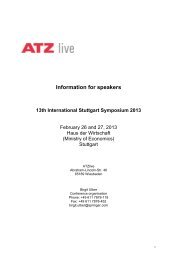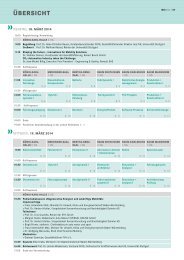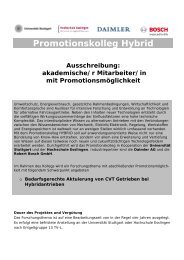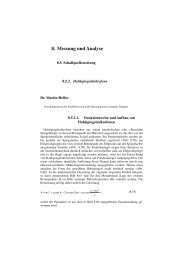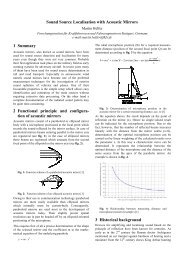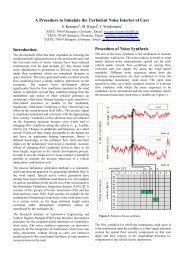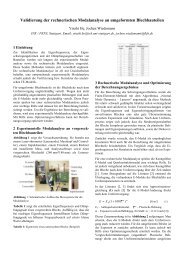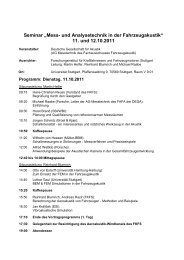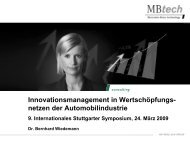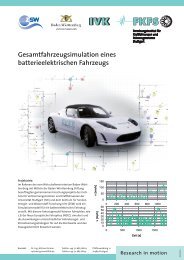using Forward-looking Information - FKFS
using Forward-looking Information - FKFS
using Forward-looking Information - FKFS
Create successful ePaper yourself
Turn your PDF publications into a flip-book with our unique Google optimized e-Paper software.
Determination of Saving Potential<br />
for a Parallel Hybrid Power Train<br />
(<strong>using</strong> <strong>Forward</strong>-<strong>looking</strong> <strong>Information</strong>)<br />
Dipl.-Ing. Thomas Riemer, <strong>FKFS</strong><br />
Dipl.-Ing. Tobias Mauk, IVK<br />
Prof. Dr.-Ing. Hans-Christian Reuss, IVK/<strong>FKFS</strong>
Abstract<br />
Anticipatory driving can lower fuel consumption of a vehicle. Because of the ability to store<br />
energy, anticipation is even more promising for hybrid power trains. The knowledge of the road<br />
to come (by means of digital road-maps) allows an energy optimal operation of the hybrid power<br />
train.<br />
An energy based investigation is not sufficient for potential-determination, because the degrees<br />
of freedom are limited by constraints. For a realistic determination of saving potentials, degrees<br />
of efficiency, storage space and maximum power of the components have to be considered. The<br />
potential of a forward-<strong>looking</strong> strategy of operation results from an optimal progression of<br />
control variables over the driving route. Control variables of a parallel hybrid power train are<br />
driving torques of combustion and electrical engine and chosen gear ratio. The determined<br />
energy consumption over the given route and given speed progression can be used as a benchmark<br />
for an implemented real-time strategy of operation.<br />
A concept for determination of optimal progression of control variables and thus a way to determine<br />
optimal energy consumption is introduced within this paper. The concept is demonstrated<br />
by a parallel-hybrid vehicle featuring a natural-gas combustion engine.<br />
1 Introduction<br />
Speaking about parallel-hybrid drive trains is sometimes difficult, because <strong>using</strong> the same vocabulary<br />
as for regular drive trains, consisting of combustion engine followed by one clutch and<br />
a gear-box, does not always apply to parallel-hybrid drive trains. The parallel-hybrid drive train<br />
examined in this paper (see Fig 1-1) consists of a combustion engine followed by a clutch,<br />
connecting it to an electrical engine, followed by a second clutch, connecting the engines to the<br />
gearbox. In this paper the clutch between combustion and electrical engine is referred to as<br />
clutch1. The clutch between the electrical engine and the gearbox is referred to as clutch2. The<br />
combination of combustion and electrical engine is referred to as the engine throughout this<br />
paper, as it replaces the combustion engine of a regular drive train.
Combustion<br />
engine<br />
Clutch1<br />
Engine<br />
Fig 1-1 Power train structure<br />
Determination of Saving Potential for a Parallel Hybrid Power Train<br />
Electrical<br />
engine<br />
Clutch2<br />
Gearbox<br />
To be able to determine fuel consumption (and thus CO2 exhaust) over a given route, the mechanical<br />
energy needed to drive the vehicle needs to be known. To determine the progression of<br />
the driving resistance, the elevation and speed progressions as well as certain parameters of the<br />
vehicle such as weight, wind drag coefficient, cross-sectional area and rolling resistance coefficient<br />
have to be known. From the progression of wheel speed and driving torque at the driving<br />
wheels the needed engine torque and engine speed for each gear can be calculated by a simple<br />
vehicle model. This is referred to as „backward simulation“ as the engine torque and speed are<br />
results of the vehicle speed, reversing the causal chain.<br />
Knowing the engine speed and torque needed throughout the route for each gear, the optimal<br />
way to meet these requirements (i.e. the required driving power) has to be determined. This is<br />
done by optimization methods resulting in vectors of gear ratio and electrical engine torque.<br />
2 Vehicle model<br />
To determine the required driving power throughout the driving route, a mathematical vehicle<br />
model has to be developed. As only energy consumption related issues are regarded, influences
y elasticity and play in the drivetrain can be disregarded. Thus the influences to be modelled<br />
are driving powers, degrees of efficiency of the electrical system and the CO2 emissions of the<br />
combustion engine.<br />
Driving powers<br />
The required driving power is dependent on the driving resistance at each time over the driving<br />
course. The driving resistance is the sum of the forces counteracting the vehicle movement<br />
(except the slope resistance that can support vehicle movement in case of downward slope):<br />
F = F + F + F + F<br />
dr<br />
rr<br />
wd<br />
a<br />
sl<br />
The driving resistance consists of the wind drag, rolling drag, acceleration resistance and slope<br />
resistance. These result in the driving resistance at the driving wheels. The driving resistance<br />
force has to be multiplied by the wheel diameter to determine the driving torque at the driving<br />
wheel. In addition to the wheel driving torque component resulting from the driving resistance,<br />
an additional torque component resulting from angular acceleration of the wheels has to be<br />
added. Although only 2 wheels are driven, obviously all four wheels have to be accelerated as<br />
the car drives on the road. So the torque of inertia of all 4 wheels has to be considered.<br />
τ = F × r + 4 J × & ω<br />
wh<br />
F dr … driving resistance<br />
F rr … rolling drag<br />
F wd … wind drag<br />
F a … acceleration resistance<br />
F sl … slope resistance<br />
dr<br />
wh<br />
wh<br />
wh<br />
τ wh … wheel driving torque<br />
F … driving resistance (3.1)<br />
dr<br />
r … wheel diameter<br />
wh<br />
J … moment of inertia of the wheel<br />
wh<br />
ω& … angular acceleration<br />
wh<br />
As only quasi-static driving states are regarded in this work, clutch slip is neglected. Thus the<br />
rotational speed relation between wheels and engine always equals the gear ratio. To determine<br />
driving torque at gearbox entry, the wheel driving torque has to be divided by the product of<br />
axle and gear ratio. Additionally the drive train efficiency has to be regarded. Although the<br />
(2.1)<br />
(2.2)
Determination of Saving Potential for a Parallel Hybrid Power Train<br />
efficiency of a drive train has constant, speed and load dependent losses [2] , a constant relation<br />
between output and input power is appropriate for this kind of research.<br />
P<br />
out<br />
= P × η ⇒ ω × τ<br />
in<br />
ωout<br />
× τ out τ out<br />
τ in = =<br />
ω × η i × η<br />
in<br />
out<br />
n<br />
out<br />
= ω × τ × η<br />
in<br />
in<br />
As the diameters of drive-shafts and gearbox-shafts are low in comparison to wheel and engine<br />
diameters, their moment of inertia will be neglected in this research. Their moment of inertia<br />
could be added to the wheels or the engine, multiplied by the square of the ratio [1] As the<br />
consumption maps for the engines are measured in static operating points, their moments of<br />
inertia have to be accounted for in addition to the gearbox entry torque. As the required torques<br />
are calculated before the operation mode is chosen, it is not known if the combustion engine<br />
has to be accelerated or not (e.g. if clutch1 is open or closed). Therefore the moment of inertia<br />
of the combustion engine is always added, assuming it is always revolving.<br />
τ<br />
τ &<br />
wh<br />
en = + ωwh<br />
in<br />
× η<br />
en<br />
P in,<br />
out … in/output powers<br />
τ in. out<br />
ωin.<br />
out<br />
ω = ω × i<br />
wh<br />
n<br />
× i × J<br />
n<br />
ω … engine angular velocity<br />
en<br />
en<br />
τ en … required engine torque<br />
J … moment of inertia of the engine (engines + clutches)<br />
en<br />
… in/output torques<br />
… in/output angular velocity<br />
i … overall gear ratio in gear n<br />
n<br />
η … drive train degree of efficiency<br />
(2.4)<br />
(2.5)<br />
With 3.4 & 3.5 the required engine torque in all gears for a given course can be calculated. Fig<br />
2-1 shows the required engine torques in all the gears compared to the vehicle speed.<br />
(2.3)
Fig 2-1 required engine torques<br />
Electrical system<br />
Electrical engine<br />
The electrical system consists of the electrical motor and the battery. This combination makes it<br />
possible to transform mechanical energy into electrical energy and vice versa. The mechanical<br />
energy can be drawn from the combustion engine as well as the kinetic energy of the vehicle.<br />
For the electrical engine a characteristic map for the current has to be determined. To generate<br />
the map, a grid of torques and revolution speeds has to be established. The current for every<br />
point of that grid has to be measured. An example for such a map is shown in Fig 2-2. The<br />
current is measured at a defined constant voltage.
Fig 2-2 characteristic map of the electrical engine<br />
Determination of Saving Potential for a Parallel Hybrid Power Train<br />
As the battery voltage will change with battery State-of-Charge (as from now abbreviated SoC)<br />
and battery current, electrical power has to be calculated from the current map by multiplying<br />
with the operation voltage used during current measurement.<br />
P ( τ , n)<br />
= I ( τ , n)<br />
× U<br />
em<br />
meas<br />
Using a degree of efficiency map is not appropriate for this purpose, as it depicts the relation<br />
between acquired mechanical power and electrical power. Regarding a start-up procedure, the<br />
mechanical power is zero as the angular speed is zero and so the product of angular speed and<br />
torque (mechanical power) is also zero. Still a current is required to produce this torque, making<br />
the degree of efficiency zero. This makes calculation of required current for a desired<br />
torque impossible, so a current map is needed.<br />
Battery<br />
(2.6)<br />
The battery model is based on the Randles battery model (Fig 2-3). This model is an origin for<br />
a variety of more complex models [3] As the simulation/optimization method is based on quasistatic<br />
states, the inductive and capacitive components are neglected. Thus only the SoC and the<br />
internal resistance will be modelled.
+<br />
Fig 2-3 Randles battery model<br />
To model the battery terminal voltage, the dependency of voltage and SoC has to be determined.<br />
The terminal voltage has to be determined for a given SoC and given current. The SoC<br />
influence has to be modelled by a characteristic curve.<br />
Fig 2-4 Battery voltage curve<br />
L<br />
The terminal voltage is also influenced by the current through the internal resistance.<br />
R1<br />
C<br />
R2<br />
-
U = U ( SoC)<br />
+ I × R<br />
term<br />
i<br />
Determination of Saving Potential for a Parallel Hybrid Power Train<br />
i<br />
The State of Charge is the integration of the current flowing into the battery, so a constant factor<br />
similar to the capacity of a capacitor can be determined. Although secondary batteries (e.g.<br />
NiMH batteries) used in hybrid-vehicles naturally discharge with time, this effect can be neglected<br />
for optimization runs spanning well under an hour.<br />
SoC(<br />
t)<br />
= Cbat<br />
× ∫ I(<br />
t)<br />
dt + SoC<br />
t<br />
t0<br />
Current calculation<br />
0<br />
To determine the SoC-change through equation (2.8) in dependance of the mechanical power of<br />
the electrical engine, the corresponding current has to be calculated.<br />
P<br />
I =<br />
U<br />
em<br />
term<br />
With (2.6, 2.7):<br />
Pem<br />
I =<br />
U + R × I<br />
i<br />
−U<br />
I =<br />
U term … terminal voltage<br />
U i … internal voltage (SoC-dependent)<br />
I … current (positive values mean loading)<br />
R i … internal resistance<br />
SoC … State of Charge<br />
SoC 0 … initial SoC<br />
C bat … equivalent battery capacity<br />
i<br />
+<br />
i<br />
U<br />
2<br />
i +<br />
2R<br />
i<br />
4P<br />
em<br />
R<br />
i<br />
(2.7)<br />
(2.8)<br />
(2.9)<br />
(2.10)
Combustion engine<br />
For the determination of the carbon dioxide emissions of the combustion engine, an emissions<br />
map is needed.<br />
Fig 2-5 Exemplary CO2 emissions for a combustion engine<br />
3 Optimization<br />
Goal of this research is to find the optimal way to drive a given road route in respect of CO2<br />
emissions with a parallel-hybrid vehicle. Degrees of freedom for that task are the chosen gear<br />
and division of needed driving torque to the two engines. An appropriate optimization method<br />
to solve this problem is dynamic programming. It is based on the Bellman-equation.<br />
„An optimal policy has the property that whatever the initial state and initial<br />
decision are, the remaining decisions must constitute an optimal policy with<br />
regard to the state resulting from the first decision.“ – Bellman, 1957
Determination of Saving Potential for a Parallel Hybrid Power Train<br />
This means that for each part of the solution vectors, the „sub“-solution has to be the optimalway<br />
between these two points.<br />
A B<br />
c=1<br />
1<br />
Fig 3-1 Dynamic Programming Step-by-step decision process<br />
Fig 3-1 illustrates the step-by-step decision process. For every state of the current step, the<br />
„cheapest“ sum of any state in the step before and the corresponding way to the current state in<br />
the current step has to be found. As there is only one state in the final step, the sum of the cost<br />
for the transition to the final state plus the overall cost to the preceding states decide the overall<br />
cost. So for every state in the current step only as many decisions as there are preceding states<br />
have to be made. So for n steps and x states the number of necessary decision is:<br />
2<br />
d = x × ( n − 3)<br />
+ 2×<br />
x<br />
The overall number of possible combinations calculates to<br />
−2<br />
= n<br />
c x<br />
2<br />
C D<br />
1<br />
c=1 5<br />
3<br />
c=5 2<br />
1<br />
c=7<br />
2<br />
c=2<br />
3<br />
c=2<br />
1<br />
c=3 4<br />
d … number of necessary decisions<br />
x … number of states<br />
n … number of steps<br />
c … number of combinations<br />
5<br />
c=6<br />
So for an optimization problem consisting of 200 steps and 100 possible states, <strong>using</strong> dynamic<br />
programming leads to 1.97 × 10 6 decisions, compared to 10 396 possible combinations.<br />
1<br />
2<br />
1<br />
2<br />
c=1<br />
3<br />
3<br />
c=2<br />
c=1<br />
c=2<br />
3<br />
3<br />
5<br />
1<br />
5<br />
1<br />
c=5<br />
c=3<br />
c=5<br />
1<br />
5<br />
c=3<br />
2<br />
4<br />
c=7<br />
c=6<br />
1<br />
3<br />
c=8<br />
(3.1)<br />
(3.2)
4 Problem modelling<br />
For comparability to production cars, the NEDC-cycle (New European driving cycle) was chosen<br />
(Fig 4-1).<br />
Fig 4-1 New European driving cycle<br />
To find the optimal way to drive a given route, an internal state of the system has to be chosen.<br />
In this case, the SoC of the battery was chosen. So the desired SoC-range is divided into an<br />
appropriate number of SoC-levels. The number of levels chosen is determined by the current<br />
necessary to go one step up/down within one time step. The current to in/decrease the SoClevel<br />
by one discrete step can be determined by transforming (2.8):<br />
SoC<br />
I<br />
C t Δ ×<br />
Δ<br />
=<br />
bat<br />
Δ SoC … SoC-level unit interval<br />
Δ t … step width<br />
(4.1)<br />
The SoC- and time-resolution should be chosen in a way, that the current (and thus the electrical<br />
power at an average battery voltage level) necessary for a SoC-in/decrease by one step<br />
corresponds to a reasonable torque resolution in the torque range of the electrical/combustion<br />
engines even at lower rotational speeds. For this problem no general solution can be presented,<br />
as it depends on the regarded components. In the research this paper is based on, a step width<br />
of 0.5 s and a resolution of 1000 SoC-levels for 10 % SoC-range was chosen.
Determination of Saving Potential for a Parallel Hybrid Power Train<br />
From the necessary driving torques (as calculated in Chapter 2), the driveable gears have to be<br />
determined. An important difference to the dynamic programming example shown in Chapter<br />
three is that the state transitions can be executed in different gears. So each transition has to be<br />
evaluated per driveable gear. This can be thought of as multivalued transitions. A gear is driveable<br />
if the sum of the maximum torques of both engines is higher than the required driving<br />
torque in that gear for positive (powering) torques. For negative torques (decelerating), all<br />
gears are possible as not all the torque has to be produced by the electrical engine. As the brake<br />
system of the car remains unmodified, only a part of the braking torque can be recuperated by<br />
the electrical system, so an upper torque percentage limit has to be defined. For the car this<br />
work is based on, the maximum torque regarded throughout the optimization procedure for the<br />
electrical engine equals a third of the decelerating torque needed.<br />
To allow battery loading during driving breaks (e.g. stops at traffic lights), an engine rotational<br />
speed is defined. It was set to 2500 rpm. This speed was chosen as the torque range is at its<br />
maximum and the area of optimal degree of efficiency is also located at that rotational speed.<br />
The minimum torque is set to zero, the maximum torque is the lower of the maximum torques<br />
of both engines. The required driving torque in this case is zero.<br />
Knowing the driveable gears, the maximum and minimum of the torque applicable for the electrical<br />
engine has to be determined. The maximum torque is the minimum selection of the torque<br />
the electrical engine can provide and the torque that is needed in the selected gear. The minimum<br />
torque is the difference between the required driving torque and the maximum torque the<br />
combustion engine can provide.<br />
τ dr ( i, t)<br />
− τ max_ ce ( n)<br />
< τ em ( t)<br />
< min( τ max_ em ( n),<br />
τ dr ( i,<br />
t))<br />
τ dr … driving torque<br />
τ max_ ce<br />
τ max_ em<br />
… maximum torque of combustion engine<br />
… maximum torque of electrical engine<br />
i … gear<br />
(4.2)<br />
From the possible torque range and the rotational speed in the regarded gear, the electrical<br />
current limits can be calculated by (2.10). By solving (4.1) for Δ SoC , the possible amount of<br />
SoC in/decrease steps for this time step and the regarded gear can be determined. As not all<br />
transitions between states of adjacent steps are possible because of the limited SoC in/decrease<br />
range, the theoretical complexity calculated with (3.1) is by far beyond the necessary number of<br />
calculations. Thus the computation time for this method is acceptable for theoretical research.<br />
With the possible SoC-level step range, the necessary electrical engine torques for the exact<br />
current to make the desired SoC-level steps have to be determined by reversing the characteristic<br />
map for the electrical engine (Fig 2-2) to provide torque from given rotational speed and<br />
current.<br />
The difference between the necessary driving torque and the electrical engine torque equals the<br />
necessary combustion engine torque. By <strong>looking</strong> up the emitted CO2 for the current rotational<br />
speed and the determined necessary torque fraction for the combustion engine in Fig 2-5, the
„cost“ for the regarded route leading to this specific state (SoC-level) can be calculated by<br />
adding the so-far emissions to the origin state of the current consideration. If no better state<br />
vector had been found, the state and gear vector as well as the CO2 emissions are stored for the<br />
regarded destination state. For simplicity reasons, the electrical engine torque vector is also<br />
stored, although it could be reconstructed from the SoC-level and gear vectors after the optimization<br />
is done.<br />
5 Results<br />
After the optimization run, the following results were derived. Fig 6-1 shows an excerpt of the<br />
progression of the regarded vectors. Shown are the required torque in the gear selected during<br />
the optimization run and the optimal electrical engine torque vector, the acquired gear and the<br />
SoC progression.<br />
The results feature multiple kinds of hybrid operating modes. During braking manoeuvres,<br />
kinetic energy is regained by recuperation. At constant velocity, the combustion engine operating<br />
point is shifted to higher loads by producing negative torque. This way the battery is<br />
charged. The stored energy is used to support the combustion engine, making it possible to<br />
select a higher gear.<br />
It is obvious that the result shows the discharge of the battery just before it is recharged at the<br />
long deceleration manoeuvre at the end of the cycle. Recuperation is always done when possible.<br />
The CO2 emissions determined for the used middle-class caravan were about 88.27 g CO2/km.<br />
Compared to the production car (1.6 liter gasoline engine, no hybrid), emitting approximately<br />
150 g CO2/km, the potential is significant. Still there would be compromises to be made in<br />
respect of driveability, comfort and comprehensibility, so a production car featuring the components<br />
simulated in this research would emit more CO2/km than the calculated value.<br />
6 Conclusion<br />
The chosen optimization approach is well suited for the given problem. It is a good way to<br />
determine the potentials for a given hardware configuration. It can also help in developing an<br />
appropriate strategy of operation and to evaluate an already established solution. Further research<br />
is required to fully understand the determined optimal solution.<br />
For a real-time implementation of the described method, the computation times are problematic.<br />
Depending on the valid SoC-range, SoC-resolution and the regarded horizon, real-time<br />
calculation can become impossible [5] . An operation strategy for a vehicle with a high-capacity<br />
battery, making it possible to use electric drive for longer periods, has to regard a far optimization<br />
horizon. Using neural networks, trained to deliver the results, the offline optimization<br />
would have, could be a solution to this problem.
Determination of Saving Potential for a Parallel Hybrid Power Train<br />
Fig 6-1 Optimization results, electrical engine torque, gear & SoC
Bibliography<br />
[1] Trägheitsmoment/Übersetzung, R. Isermann, Springer 2002<br />
[2] Powertrain Performance vs. Engine Performance,<br />
White Paper, Rototest Research Institute, 2005<br />
[3] Electrochemistry, Carl H. Hamann, Andrew Hamnett, Wolf Vielstich,<br />
WILEY-VCH, 2007<br />
[4] Optimal Control, Richard Vinter, Birkhäuser Boston, 2000<br />
[5] Prädiktive Antriebsregelung zum energieoptimalen Betrieb von Hybridfahrzeugen, M.<br />
Back, Dissertation, Universitätsverlag Karlsruhe, 2005



